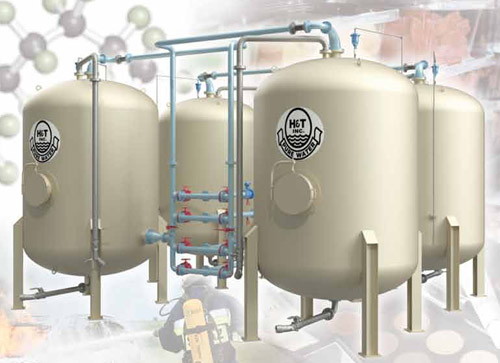PFAS Waste Management for Safer Disposal and Environmental Protection
PFAS Waste Management for Safer Disposal and Environmental Protection
Blog Article
Innovative PFAS Treatment Solutions for Safer Water
The boosting frequency of PFAS contamination in water materials requires an important assessment of innovative treatment options. In addition, arising bioremediation methods use a more lasting method to dealing with PFAS obstacles. pfas management.
Overview of PFAS Contamination
PFAS contamination has arised as a substantial ecological and public wellness problem. Per- and polyfluoroalkyl materials (PFAS) are a group of synthetic chemicals recognized for their persistence in the environment and body, leading them to be commonly described as "forever chemicals." These substances have been commonly made use of in numerous industries, consisting of firefighting foams, water-repellent materials, and food packaging, mainly due to their water- and grease-resistant properties.
The prevalent use of PFAS has resulted in their discovery in soil, water supplies, and even in the blood of humans and pets. Studies have linked PFAS direct exposure to various health and wellness problems, consisting of developmental effects in infants, immune system dysfunction, and numerous kinds of cancer. In addition, the environmental persistence of these substances complicates their degradation and removal, elevating issues regarding long-lasting environmental influences.
Regulative bodies are progressively applying rigorous guidelines to monitor and reduce PFAS levels in alcohol consumption water and various other environmental tools. As recognition of PFAS contamination expands, it has actually become necessary for communities and markets to look for efficient treatment services to alleviate exposure and safeguard public health and wellness.
Advanced Filtering Technologies
As the seriousness to address PFAS contamination intensifies, advanced filtration innovations have actually arised as a crucial part in the remediation initiatives focused on removing these relentless chemicals from water sources. These modern technologies leverage advanced mechanisms to properly target and record PFAS compounds, which are infamously resistant to conventional treatment methods.
Among one of the most promising approaches is using granular triggered carbon (GAC), which adsorbs PFAS molecules because of its high area and permeable structure. This technique has actually been widely carried out in both metropolitan and commercial settings, showing substantial decreases in PFAS concentrations. In addition, ion exchange materials have gained grip, specifically created to uniquely bind PFAS ions from water, hence promoting their removal.
Membrane filtration technologies, such as reverse osmosis and nanofiltration, likewise show efficacy in PFAS elimination by literally dividing contaminants from water - pfas management. These systems can achieve high levels of purity, making them appropriate for drinking water applications
Chemical Therapy Developments
Countless chemical therapy technologies are being explored to effectively address PFAS contamination in water supplies. One promising method entails making use of sophisticated oxidation processes (AOPs), which use effective oxidants such as ozone, hydrogen peroxide, or chlorine dioxide combined with UV light to damage down PFAS compounds into less dangerous materials. This technique has shown efficacy in lab setups, revealing possible for scalability in real-world applications.
One more innovative approach is the advancement of ion-exchange materials specifically developed to target PFAS. These resins can precisely adsorb PFAS substances from water, permitting their removal throughout treatment processes. Recent innovations visit this web-site have enhanced the effectiveness and ability of these materials, making them a desirable choice for water treatment centers.
In addition, researchers are investigating the use of chemical agents like persulfate and ferrous ions to boost the deterioration of PFAS in polluted water. These representatives can generate chemical reactions that help with the malfunction of persistent PFAS substances.
Emerging Bioremediation Methods
Current developments in chemical therapy innovations have actually led the way for exploring bioremediation methods as a viable option for addressing PFAS contamination. Bioremediation takes advantage of the all-natural metabolic procedures of microbes to weaken or transform contaminants, making it an attractive technique for taking on persistent impurities like PFAS.
Emerging strategies in bioremediation include the usage of genetically reference crafted microorganisms that can particularly target and damage down PFAS compounds. These microbial pressures are being created for their improved destruction abilities, raising the efficiency of the remediation procedure. Additionally, scientists are checking out the potential of plant-assisted bioremediation, where particular plant types may uptake and sequester PFAS from polluted soil and water.
An additional appealing technique is the application of bioaugmentation, which involves introducing helpful microbes right into contaminated settings to increase the deterioration of PFAS. This method can facilitate faster remediation timelines and improve overall efficiency.

Regulatory Frameworks and Requirements
A thorough governing framework is crucial for effectively taking care of PFAS contamination and making sure public health and wellness protection. The enhancing recognition of per- and polyfluoroalkyl materials (PFAS) as environmental pollutants has triggered different government and state agencies to develop standards that control their visibility in water materials. The United State Environmental Security Firm (EPA) has developed health and wellness advisories and is pursuing establishing enforceable limitations for PFAS in drinking water.
State-level laws differ dramatically, with some states embracing stricter standards than those proposed by the EPA. These policies frequently consist of maximum contaminant levels (MCLs) for certain PFAS compounds, surveillance needs, and reporting responsibilities for water utilities. Furthermore, emerging frameworks concentrate on the removal of polluted websites, highlighting the requirement for reliable treatment innovations.

Verdict
To conclude, the advancement and execution of innovative PFAS therapy options are vital for resolving the prevalent issue of water contamination. Advanced purification modern technologies, chemical therapies, and arising bioremediation techniques jointly present a multifaceted technique to efficiently lower and weaken PFAS degrees. As regulatory frameworks continue to evolve, integrating these innovations will be essential to secure public wellness and bring back the stability of contaminated water sources, inevitably adding to a cleaner and much safer environment.
Report this page